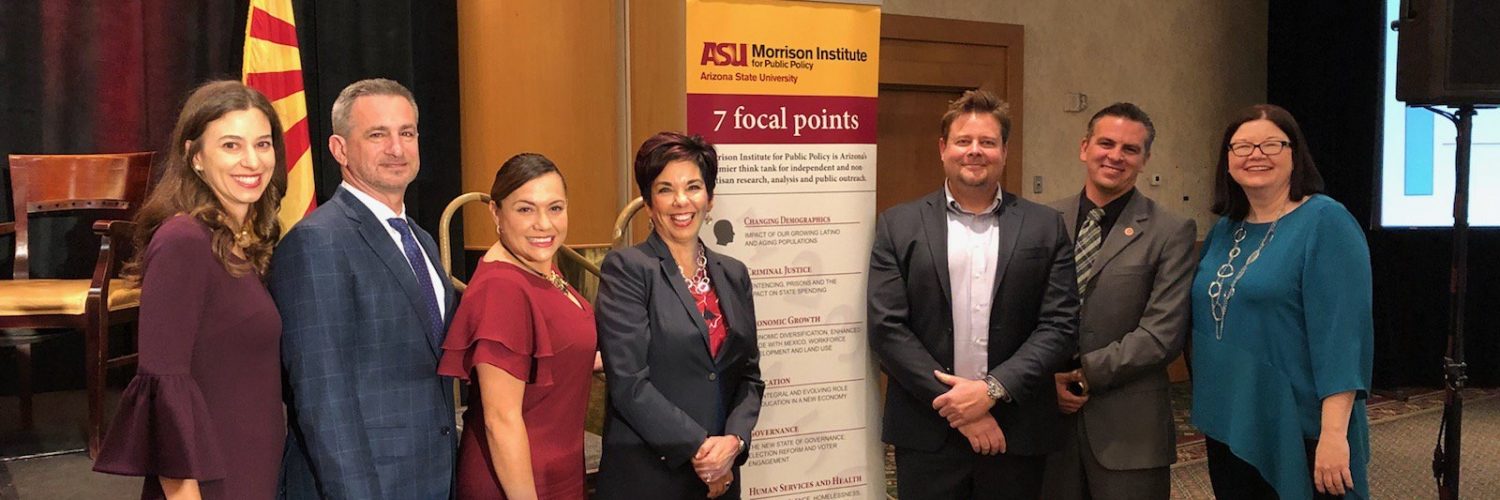Three weeks have passed since the historic 2018 election.
With a voter turnout of more than 60 percent, Arizona saw the highest turnout than in any other midterm election on record.
However, the unusual midterm left political analysts, and Arizonans, with some questions about what this means for the future of Arizona.
Local and national political experts joined the Arizona State University’s Morrison Institute for Public Policy for its annual “State of our State” conference where they discussed what they believe this means for the future of the United States.
Is there still a voter crisis?
The Morrison Institute still believes there is a voter crisis.
Joseph Garcia, director of communication and community impact for the Morrison Institute, compared the election to Arizona having its wettest October on record.
One good rain does not end a drought – and one good turnout does not end a voter crisis.
Garcia pointed out that while there was a 63 percent voter turnout, that was a 63 percent turnout of registered voters. Only 48 percent of eligible voters in Arizona voted.
“Is it a crisis that we’re at [52] percent of non participation of citizens who can vote but don’t? I would say that as long as we can say, ‘voters don’t determine elections, nonvoters do,’ I would say that’s a crisis,” Garcia said.
Was there a blue wave?
Nationally, Republicans lost control of the House but kept control of the Senate.
Locally, Arizonans elected a significant number of Democrats to both federal and state level offices.
Kyrsten Sinema (D) was elected to U.S. Senate becoming Arizona’s first female Senator and the first Democrat to hold the position in more than 20 years.
The state is sending Democrats to the U.S. House of Representatives: Tom O’Halleran (CD-1); Ann Kirkpatrick (CD-2); Raul Grijalva (CD-3); Ruben Gallego (CD-7); and Greg Stanton (CD-9).
Three democrats were elected to statewide offices: Katie Hobbs, Secretary of State; Kathy Hoffman, Superintendent of Public Instruction; and Sandra Kennedy, Corporation Commissioner.
While Republicans kept control of both the Arizona State House and Senate, Democrats flipped some seats from red to blue and minimized the Republican majority in the House. The Senate will remain at 17-13 in Republican favor, but the House will hold the closest margin in almost 60 years with 31 Republicans and 29 Democrats.
So, does that constitute a blue wave?
According to Eugene Scott, political reporter for the Washington Post, “the most accurate way to answer that is [that] it was definitely not a red wave, especially if you look at state legislatures and when you look at amendments that passed across the country, like in Florida with former inmates being able to receive voting rights again, that were overwhelmingly supported by the left.”
On the other hand, David Byler, chief elections analyst and staff writer for The Weekly Standard, said he considers it a blue wave if the results will make it harder for President Donald Trump.
“It’s hard to see it as anything other than a negative verdict on Donald Trump. The most credible pushback is that if you think a wave is identified as who gets governing power, then it’s more mixed. If you’re thinking of it in terms of public opinion, it’s a blue wave,” he said.
“What you are seeing is a middle wave. It’s a signal of voters saying, ‘We are done with the blue wave and with the red. We are looking for something else.’ That’s what is most interesting now — this middle ground,” Elvia Diaz, columnist for The Arizona Republic, added.
Is Arizona purple and will it be a swing state in 2020?
“Is it a new day for Arizona? I think we’re going back to our roots. We had conservative Democrats, we had Burton Barr. We’re a place that gets things done, and it’s more about the people and less about the team,” Janice Palmer, vice president and director of policy, Helios Education Foundation, said.
All the panelists – Garrett Archer, Senior Analyst for Elections, Secretary of State’s Office; Neil Giuliano, President and CEO, Greater Phoenix Leadership; Palmer; Jim Rounds, President, Rounds Consulting Group, Inc.; and Anna Tovar, Mayor of Tolleson – believe that Arizonans are starting to pick candidates based on their campaigns, personalities and stances, rather than their party affiliation.
“What was most surprising is that you saw voters, especially independents, choosing Ms. Sinema at the top of the ticket and reverting to Mr. Ducey [for governor],” Archer said. “That began a series of ticket splitting. Maricopa County sent a clear message that, ‘we’re not going to put up with majority red or majority blue. We’re going to split our ticket, and you should too.'”
“For 2020, I think we are without a doubt now a swing state. The level of elected officials from both parties will drum up interest,” Giuliano added.
The panelists expanded on the topic discussing what this means for the state Legislature. Will there be gridlock or will a more diverse set of lawmakers better suit Arizonans?
According to Rounds, “it’s not bad to have more balance in government. It allows for more discussion. When we talk about having balance in government, we see the very far right and the very far left, and the key is to move more in the middle.”
“With a more balanced Legislature, they will need to work together to pass these issues, and one of them is education,” said Tovar.
“Republicans have a lot of ground to make up in those swing districts. Going into 2020, what these new legislators have to do, and also maybe the Republicans who will try to take these areas back, is really talk to those specific issues and try to decouple from national things as much as possible. The Ahwatukee-Chandler area, north Phoenix are areas that are very attached to the issues that played well for the Democratic Party. Education was a huge issue,” Archer added.
All ballots have been recorded and election results will be canvassed on December 3rd.
















Add comment